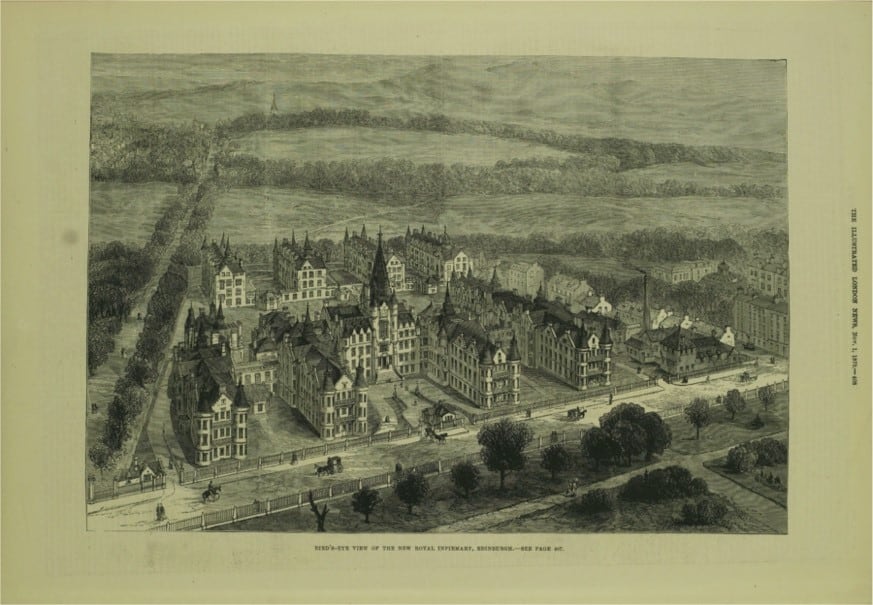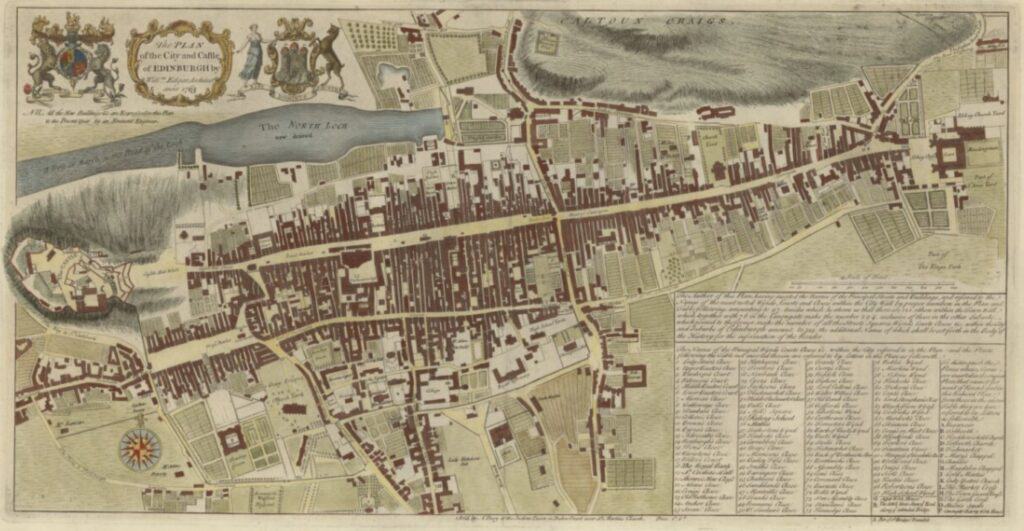Not long after I took on a role as Director of Data Civics, we started work on a film about how the Edinburgh Futures Institute was coming to life in the main building of the former Royal Infirmary of Edinburgh.
The aim was to tell a story about how the history of the building was written into the whole project of EFI. The hospital was laid out on the Nightingale or Pavilion system, with long wards and high windows, designed to isolate and close down contagion. It also had Patet Omnibus, Latin for ‘open to all’ –inscribed over its main entrance. Maintaining a balance between these almost irreconcilable ambitions – to close down and stay open – was part of the everyday working practices of the hospital. For EFI the challenge is to turn a building designed to quarantine and contain infection into a public atmosphere, a place where data fuels a contagious democratic, and following Edinburgh’s own sociological polymath Patrick Geddes’ lead, a civic intellect.
“For those who don’t know Edinburgh it may be hard to grasp how gaping a hole that left.”
The Royal Infirmary was still a working hospital when I left Edinburgh in the 1990s to do a PhD at the Open University. By the time I managed to find my way back in 2018 the hospital had moved to Little France on the southern flank of the city and the site had been shuttered for more than 15 years. For those who don’t know Edinburgh it may be hard to grasp how gaping a hole that left. Because of where it was, how long it had stood there and what had happened in there, its dereliction was deeply felt.
Amid the tastefully manicured and privately managed redevelopment known as Quartermile the site lies to the immediate north of the Meadows and a little to the south of the Old Town. It is flanked by university buildings, restaurants, pubs, George Heriot’s school, and, just to the east, one of Scotland’s most multiply deprived areas. It is, in other words, smack bang in the middle of civic life. As the largest hospital in the city – and in the United Kingdom when it opened in 1879 – the building is a relic for stories of birth and accident, disease and death, suffering and recovery. Cities, Patrick Geddes wrote, are more than a place in space, they are a drama in time, but hospitals, well, they are a melodrama in time. In the thick of the novel coronavirus, we have all had sudden and sharp cause to feel this.

On Civic Sentiment
All hospitals matter to a city’s sense of itself, but maybe especially so in a city like Edinburgh. By some reckonings Edinburgh is the least Scottish of Scotland’s cities. The percentage of its population born outside the UK, at 15.9 per cent, is double the Scottish average and just 49 per cent described their national identity as ‘Scottish only’ in contrast to Glasgow’s 62 per cent in the 2011 Census [i]. When you add to this the character of a place so deeply rooted in both the short-term visitor economies of tourism and festivals, and the dynamic economies of universities, there is a kind of jealous attachment to the parks, libraries and buildings that are open, public and there all year round. This has led to intense and bitter disputes over how goods designed for public, civic consumption are being governed. Hosting a product branded ‘Edinburgh’s Christmas’ in Princes Street Gardens, building a new Virgin hotel that will change how light hits the Carnegie endowed Edinburgh Central Library (ironically a building inscribed with the injunction ‘let there be light’), privately financing the Quaich project in West Princes Street Gardens, have all encroached on public sentiment about what parts of the city should be open and common and what can be closed and private.

We called the film ‘closes and opens’ partly because this tension is so deeply embedded in how cities plan and think about the future. Historically, and topographically, it’s a tension that is especially resonant in Edinburgh, a city of knots and layers, acute angles, dark corners and sudden open expanses. Edgar’s 1765 plan of the city gives a hint of this with its fish skeleton of very narrow streets wedged between the Nor loch, Castle Rock, Calton Hill and Salisbury Crags. Most of these streets are closes, with a soft, unvoiced ‘s’. There are roughly 66 of them opening on to the five streets that make up the Royal Mile in the Old Town. These closes were private, gated properties, often named after their owners and some still are. Others, like Fleshmarket Close and Warriston Close, are now public thoroughfares. Some no longer exist or are inaccessible because of the series of bridges and streets that were constructed on top of them to link up with the New Town in the south. Victoria Street, the Mound, Cockburn Street, the George IV and North Bridges, all wind up and over the closes of the Old Town.
The best-known casualty is Mary King’s Close. The legend that the Close was sealed up in 1644 with 600 plague victims quarantined inside has had more of a hold on urban memory than the duller truth that its partial closure was a planning decision taken to build the City Chambers. The rest was truncated to make way for Cockburn St. Mary King’s Close has been closed, opened, closed and opened again, in and out of private ownership, since the seventeenth century. Parts of it opened once more as the Real Mary King’s Close, a tourist attraction in 2003. This pattern repeats and varies across the Old Town. The closes are notorious now for lockboxes – the mark of the short-term private lets that take up roughly 29% of housing stock.
On Data Civics Technique
What should be closed, what should be open, what should be public, what should be private? These problems are framed and reframed as the city projects a data capital future. But how do you build the future for a city with such a glamorous past? Glamer in Scots was an act, a sort of spell that afflicts the eyesight, before Walter Scott made an English noun of it. And Edinburgh is a city that glamours: It is Walter Scott’s -‘piled deep and massy, close and high’, Robert Louis Stephenson’s Jekyll and Hyde, a city Hugh MacDiarmid called in one poem a ‘mad god’s dream’ and damned in another as ‘too stupid yet to learn how not to stand in her own light’.
“What should be closed, what should be open, what should be public, what should be private?”
Even the nickname Auld Reekie, for MacDiarmid, smoke signalled the city’s ‘monstrous acquiescence’ to ends, its dark undertow. The capital of Scotland, he wrote, needed to learn how to consume her own smoke. It still does – even if the fumes are now from a massive data exhaust. The rancour of the Twitter debate surrounding the appropriation of East Princes Street Gardens for ‘Edinburgh’s Christmas’ by the live events company Underbelly, is, like the role of Airbnb, Deliveroo and Uber, another mark of the tensions alive in a data capital fuelled by the platform economy.

The programme of Data Civics is being designed to work with this atmosphere by combining a bit of the analytical technique of big data to listen in and watch what the city is saying and a bit of the dramatic sentiment to replay it back to it. The aim is to gather, amplify and orchestrate the diversity of civic voices. Patrick Geddes saw a concrete need in cities for scientific centres of observation and record on the one hand, and for experimental endeavour, on the other. Edinburgh’s Camera Obscura building at top of the Royal Mile remains an architectural marker of his Outlook Tower project for a coordinated sociological observatory and experimental laboratory.
“Closes and Opens was a study of the historical character of the kind of future planning EFI is engaged in”
Today, cities’ evolutions, their pasts and their futures are accessible in new ways by combining digitised historical archive with the massive, passive, behavioural data generated through the transactions of everyday life in the city. Digitalisation alters proximities, it changes what, where and who is far and near. It alters accessibilities too, changing what is open and common, what is closed and private and to whom. Closes and Opens was a study of the historical character of the kind of future planning EFI is engaged in. It was also a research and methodological experiment in how to read and engage the city. Our long-term aim is to develop toolkits for mass, digital observation that make expertise accessible and engender civic participation. Computational approaches to massive, passive and visual data can change how cities are seen. It is possible now to re-envision civic planning, to record voices usually absent from formal consultation, to develop apps that render archive material more accessible and to promote creative participation through online and offline conversation. It is, as we have been forced by the novel coronavirus to learn in sudden unplanned experiments, even possible to do some of this work remotely, to listen, watch and play with the city, virtually. In the end though the work of making places civic, social and safe is material – it needs the physical co-presence of people, animals and things.
There are worse ways to fill the gap left by the Royal Infirmary than by becoming a physical, architectural marker of the civic, global demand to keep a watch on all our futures.
Closes and Opens premiered in a live stream screening on Thursday 30 April, 2020. The film was produced, written and narrated by Liz McFall and AWED for the Edinburgh Futures Institute. You can watch the film here. And be sure to join our mailing list to stay up-to-date with our events and future screenings.





